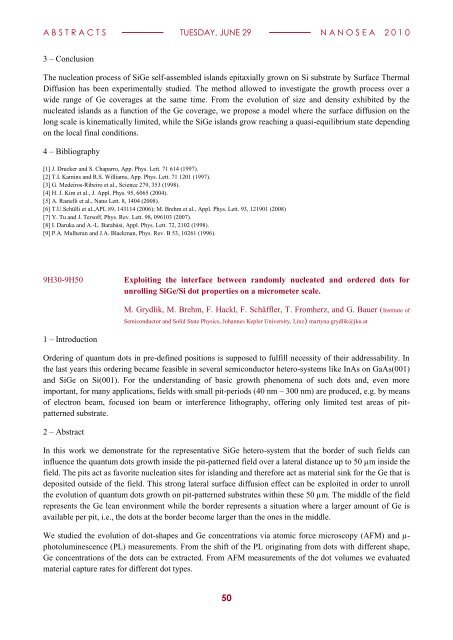book of abstracts - IM2NP
book of abstracts - IM2NP
book of abstracts - IM2NP
Create successful ePaper yourself
Turn your PDF publications into a flip-book with our unique Google optimized e-Paper software.
A B S T R A C T S TUESDAY, JUNE 29 N A N O S E A 2 0 1 0<br />
3 – Conclusion<br />
The nucleation process <strong>of</strong> SiGe self-assembled islands epitaxially grown on Si substrate by Surface Thermal<br />
Diffusion has been experimentally studied. The method allowed to investigate the growth process over a<br />
wide range <strong>of</strong> Ge coverages at the same time. From the evolution <strong>of</strong> size and density exhibited by the<br />
nucleated islands as a function <strong>of</strong> the Ge coverage, we propose a model where the surface diffusion on the<br />
long scale is kinematically limited, while the SiGe islands grow reaching a quasi-equilibrium state depending<br />
on the local final conditions.<br />
4 – Bibliography<br />
[1] J. Drucker and S. Chaparro, App. Phys. Lett. 71 614 (1997).<br />
[2] T.I. Kamins and R.S. Williams, App. Phys. Lett. 71 1201 (1997).<br />
[3] G. Medeiros-Ribeiro et al., Science 279, 353 (1998).<br />
[4] H. J. Kim et al., J. Appl. Phys. 95, 6065 (2004).<br />
[5] A. Rastelli et al., Nano Lett. 8, 1404 (2008).<br />
[6] T.U.Schülli et al.,APL 89, 143114 (2006); M. Brehm et al., Appl. Phys. Lett. 93, 121901 (2008)<br />
[7] Y. Tu and J. Ters<strong>of</strong>f, Phys. Rev. Lett. 98, 096103 (2007).<br />
[8] I. Daruka and A.-L. Barabàsi, Appl. Phys. Lett. 72, 2102 (1998).<br />
[9] P.A. Mulheran and J.A. Blackman, Phys. Rev. B 53, 10261 (1996).<br />
9H30-9H50<br />
Exploiting the interface between randomly nucleated and ordered dots for<br />
unrolling SiGe/Si dot properties on a micrometer scale.<br />
M. Grydlik, M. Brehm, F. Hackl, F. Schäffler, T. Fromherz, and G. Bauer (Institute <strong>of</strong><br />
Semiconductor and Solid State Physics, Johannes Kepler University, Linz) martyna.grydlik@jku.at<br />
1 – Introduction<br />
Ordering <strong>of</strong> quantum dots in pre-defined positions is supposed to fulfill necessity <strong>of</strong> their addressability. In<br />
the last years this ordering became feasible in several semiconductor hetero-systems like InAs on GaAs(001)<br />
and SiGe on Si(001). For the understanding <strong>of</strong> basic growth phenomena <strong>of</strong> such dots and, even more<br />
important, for many applications, fields with small pit-periods (40 nm – 300 nm) are produced, e.g. by means<br />
<strong>of</strong> electron beam, focused ion beam or interference lithography, <strong>of</strong>fering only limited test areas <strong>of</strong> pitpatterned<br />
substrate.<br />
2 – Abstract<br />
In this work we demonstrate for the representative SiGe hetero-system that the border <strong>of</strong> such fields can<br />
influence the quantum dots growth inside the pit-patterned field over a lateral distance up to 50 µm inside the<br />
field. The pits act as favorite nucleation sites for islanding and therefore act as material sink for the Ge that is<br />
deposited outside <strong>of</strong> the field. This strong lateral surface diffusion effect can be exploited in order to unroll<br />
the evolution <strong>of</strong> quantum dots growth on pit-patterned substrates within these 50 µm. The middle <strong>of</strong> the field<br />
represents the Ge lean environment while the border represents a situation where a larger amount <strong>of</strong> Ge is<br />
available per pit, i.e., the dots at the border become larger than the ones in the middle.<br />
We studied the evolution <strong>of</strong> dot-shapes and Ge concentrations via atomic force microscopy (AFM) and µ-<br />
photoluminescence (PL) measurements. From the shift <strong>of</strong> the PL originating from dots with different shape,<br />
Ge concentrations <strong>of</strong> the dots can be extracted. From AFM measurements <strong>of</strong> the dot volumes we evaluated<br />
material capture rates for different dot types.<br />
50

















